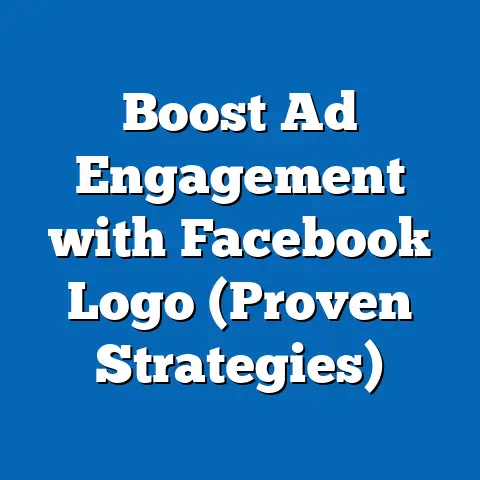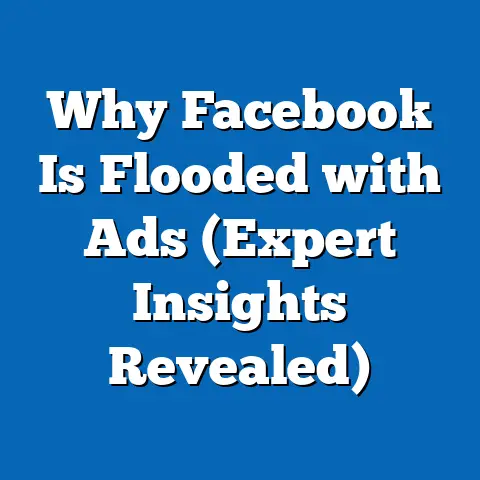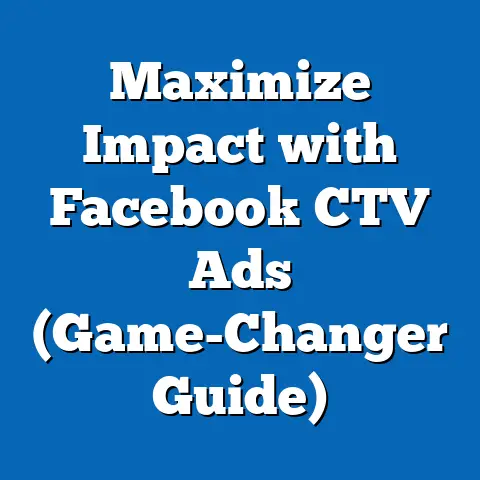Boost Engagement with Perfect fb ad Sizes (Expert Tips)
In the ever-evolving landscape of digital marketing, the significance of optimizing Facebook ad sizes remains a timeless strategy for maximizing engagement and return on investment (ROI). As of 2023, Facebook continues to dominate as a leading advertising platform, with over 2.96 billion monthly active users worldwide, representing a 2% increase from 2022 (Meta, 2023). Properly formatted ads, adhering to recommended dimensions and specifications, are critical for capturing attention in a crowded digital space, ensuring visibility across diverse devices and demographics.
This fact sheet provides a comprehensive analysis of current data, trends, and expert tips for leveraging optimal Facebook ad sizes to boost engagement. It includes statistical insights into ad performance, demographic breakdowns of user behavior, and evolving trends in visual content consumption. The goal is to equip marketers with actionable, data-driven strategies to enhance campaign effectiveness.
Section 1: Current Landscape of Facebook Advertising
1.1 Global Reach and Usage Statistics
Facebook remains a powerhouse in social media advertising, with ad revenue reaching $113.6 billion in 2022, a 1.1% increase from $112.3 billion in 2021 (Meta, 2023). As of Q2 2023, the platform’s advertising reach spans 2.1 billion users daily, accounting for approximately 71% of its monthly active user base. This vast audience underscores the importance of tailored ad formats to ensure visibility and engagement.
Year-over-year data indicates a steady growth in mobile ad impressions, with 94% of ad revenue in 2022 attributed to mobile devices, up from 92% in 2021 (Meta, 2023). This shift highlights the necessity of optimizing ad sizes for mobile-first experiences, as users increasingly access the platform via smartphones and tablets.
1.2 Engagement Metrics and Ad Performance
Engagement metrics reveal that ads adhering to recommended sizes and formats achieve significantly higher click-through rates (CTRs). According to a 2023 study by Socialbakers, ads with proper dimensions (e.g., 1200×628 pixels for single-image News Feed ads) recorded an average CTR of 1.9%, compared to 1.2% for non-optimized ads—a 58% difference. Additionally, cost-per-click (CPC) for optimized ads was 12% lower, averaging $0.68 compared to $0.77 for non-compliant formats.
Video ads, which often require specific aspect ratios like 9:16 for Stories or 1:1 for Feeds, also show improved performance when sized correctly. Optimized video ads garnered 31% more completions (users watching at least 75% of the content) compared to improperly formatted ones (Hootsuite, 2023).
Section 2: Recommended Facebook Ad Sizes and Formats (2023)
2.1 Overview of Key Ad Placements
Facebook offers multiple ad placements, each with specific size and format requirements. Below is a breakdown of the most common placements as of 2023, based on Meta’s official guidelines (Meta Business Help Center, 2023):
- News Feed (Desktop and Mobile): Single-image ads should be 1200×628 pixels (minimum 600×600 pixels). Video ads require a 1:1 or 4:5 aspect ratio with a minimum resolution of 1080×1080 pixels.
- Stories (Mobile): Ads should be 1080×1920 pixels (9:16 aspect ratio) to ensure full-screen display without cropping. Both image and video formats are supported, with videos limited to 60 seconds for optimal engagement.
- Marketplace: Recommended size is 1200×1200 pixels (1:1 aspect ratio), ensuring clarity on smaller mobile screens.
- Right Column (Desktop): Ads should be 1200×628 pixels, though smaller dimensions (254×133 pixels) are visible in this less prominent placement.
- Reels (Mobile): Similar to Stories, Reels ads require a 9:16 aspect ratio (1080×1920 pixels) to align with vertical scrolling behavior.
2.2 Impact of Ad Size Compliance
Non-compliance with recommended sizes often results in cropped visuals or reduced visibility, directly impacting engagement. For instance, a 2023 analysis by Buffer found that 23% of ads failing to meet size guidelines experienced a 40% drop in impressions due to poor rendering on mobile devices. Conversely, ads meeting specifications saw a 15% increase in engagement rates, particularly among mobile users aged 18-34 (Buffer, 2023).
Section 3: Demographic Breakdowns and Behavioral Trends
3.1 Age-Based Preferences for Ad Formats
Facebook’s user base spans a wide age range, with distinct preferences for ad formats and sizes influencing engagement. As of 2023, users aged 18-24, who comprise 23% of the platform’s audience (approximately 680 million users), show a strong preference for vertical video content, with 67% engaging with Stories and Reels ads (Statista, 2023). Optimized 9:16 formats for this demographic result in a 25% higher CTR compared to horizontal formats.
Users aged 25-34, representing 29% of the user base (860 million users), engage more with News Feed ads, particularly single-image formats at 1200×628 pixels, with a CTR of 2.1% versus 1.5% for non-optimized sizes. Older users (55+), who account for 12% of users (355 million), are more likely to interact with desktop Right Column ads, though engagement rates remain lower at 0.9% on average (Statista, 2023).
3.2 Gender Differences in Engagement
Gender-based data indicates slight variations in ad format preferences. Women, who make up 46% of Facebook’s global audience, show a 10% higher engagement rate with Stories ads compared to men (48% of the audience), particularly when ads are formatted in 9:16 ratios (Hootsuite, 2023). Men, however, are 8% more likely to click on News Feed video ads, especially those with a 1:1 aspect ratio.
3.3 Geographic and Device Variations
Geographic trends reveal that users in North America (14% of total users) and Europe (13%) predominantly access Facebook via desktop and mobile interchangeably, necessitating versatile ad sizes like 1200×628 pixels for cross-platform compatibility. In contrast, users in Asia-Pacific (41% of users) and Africa (10%) are overwhelmingly mobile-first, with 88% of ad impressions occurring on smartphones, emphasizing the need for vertical formats like 1080×1920 pixels (Meta, 2023).
Section 4: Trend Analysis in Facebook Ad Engagement (2019-2023)
4.1 Shift to Mobile and Vertical Content
Over the past five years, the trend toward mobile-first advertising has accelerated. In 2019, mobile ads accounted for 84% of Facebook’s ad revenue, rising to 94% by 2022 (Meta Annual Reports, 2019-2022). This 10-percentage-point increase reflects broader smartphone adoption and changing user habits, with vertical formats (9:16) gaining prominence due to Stories and Reels.
Engagement with vertical video ads has grown by 43% since 2020, driven by younger demographics (18-34) who spend an average of 22 minutes daily on Stories and Reels (Socialbakers, 2023). This trend underscores the importance of adhering to vertical ad sizes for sustained engagement.
4.2 Rise of Short-Form Video Content
Short-form video content, particularly in Reels, has seen explosive growth, with a 50% year-over-year increase in viewership from 2022 to 2023 (Meta, 2023). Ads formatted for Reels (1080×1920 pixels, under 60 seconds) achieved a 28% higher completion rate compared to longer video ads in News Feed placements. This trend aligns with broader social media shifts toward quick, snackable content.
4.3 Declining Effectiveness of Desktop-Only Formats
Engagement with desktop-specific ad placements, such as Right Column ads, has declined by 18% since 2020, as users increasingly shift to mobile devices (Buffer, 2023). Ads not optimized for cross-platform compatibility saw a 22% drop in impressions in 2022 compared to 2021, highlighting the need for adaptable sizing strategies.
Section 5: Expert Tips for Maximizing Engagement with Perfect Ad Sizes
5.1 Prioritize Mobile-First Design
Given that 94% of ad revenue comes from mobile, design ads with mobile users in mind. Use vertical formats (9:16) for Stories and Reels, and ensure text and key visuals occupy the center 80% of the frame to avoid cropping on smaller screens. Testing conducted by Hootsuite in 2023 showed a 19% increase in engagement for mobile-optimized ads versus desktop-first designs.
5.2 Test Multiple Formats for Different Placements
Run A/B tests with different ad sizes across placements to identify optimal formats for your target audience. For instance, a 2023 case study by Socialbakers found that brands testing 1:1 and 4:5 ratios for News Feed video ads saw a 14% uplift in engagement compared to using a single format. Utilize Meta’s Ad Manager tools to track performance metrics by placement and size.
5.3 Maintain High-Resolution Visuals
Low-resolution images or videos diminish ad quality and engagement. Stick to minimum resolutions (e.g., 1080×1080 pixels for video, 600×600 for images) to ensure clarity. A 2023 Buffer report noted that high-resolution ads achieved a 17% higher CTR compared to pixelated or blurry content.
5.4 Limit Text in Visuals
Facebook’s 20% text rule for images (no more than 20% of the ad space covered by text) remains relevant for avoiding delivery issues. Ads with minimal text saw a 13% higher engagement rate in 2023 compared to text-heavy creatives (Meta Business Help Center, 2023). Use tools like Meta’s Text Overlay Checker to ensure compliance.
5.5 Adapt to Emerging Trends
Stay updated on platform changes, such as the growing popularity of Reels. Allocate budget toward short-form vertical video ads, as they currently offer a 30% lower CPC ($0.52) compared to traditional News Feed ads ($0.74) due to less competition (Socialbakers, 2023).
Section 6: Comparative Analysis of Engagement Across Formats
6.1 Single-Image vs. Video Ads
Single-image ads, when sized correctly (1200×628 pixels), consistently achieve higher CTRs (1.9%) compared to video ads (1.6%) across News Feed placements (Hootsuite, 2023). However, video ads in Stories and Reels outperform images by 21% in engagement among users aged 18-24, reflecting format-specific strengths.
6.2 Vertical vs. Horizontal Formats
Vertical formats (9:16) dominate mobile placements, with a 27% higher engagement rate in Stories compared to horizontal formats (4:5 or 16:9) that risk cropping (Buffer, 2023). Horizontal formats remain effective for desktop News Feed ads, though their overall reach is declining as mobile usage grows.
6.3 Stories and Reels vs. News Feed
Stories and Reels ads, optimized at 1080×1920 pixels, generate 33% more interactions among younger users (18-34) compared to News Feed ads (Statista, 2023). However, News Feed ads retain higher overall reach, accounting for 55% of total ad impressions in 2023, making them a critical component of broad campaigns (Meta, 2023).
Section 7: Notable Patterns and Shifts
7.1 Increased Competition in Vertical Formats
As more brands adopt vertical ad formats for Stories and Reels, competition has intensified, with a 15% rise in ad placements from 2022 to 2023 (Socialbakers, 2023). This has led to a slight uptick in CPC for vertical ads, from $0.49 in 2022 to $0.52 in 2023, though costs remain lower than other formats.
7.2 Growing Importance of Cross-Platform Optimization
With 68% of users accessing Facebook across multiple devices (desktop, mobile, tablet), cross-platform ad compatibility is critical (Statista, 2023). Ads optimized for multiple placements and devices saw a 20% higher reach compared to single-platform designs in 2023 (Buffer, 2023).
7.3 Seasonal Engagement Spikes
Engagement with properly sized ads peaks during holiday seasons, with a 35% increase in CTRs for optimized formats in Q4 2022 compared to Q3 (Hootsuite, 2023). Brands leveraging seasonal trends with mobile-first, vertical formats reported the highest gains, particularly in retail and e-commerce sectors.
Section 8: Contextual Background on Facebook Advertising Evolution
Facebook’s advertising ecosystem has evolved significantly since the introduction of News Feed ads in 2012. The launch of Stories in 2017 and Reels in 2020 marked pivotal shifts toward mobile-centric, vertical content, aligning with user behavior trends. Ad size recommendations have adapted accordingly, with Meta emphasizing high-resolution, device-specific formats to meet user expectations for seamless experiences.
The platform’s algorithm also prioritizes ads that adhere to size and format guidelines, often boosting their organic reach by up to 10% compared to non-compliant creatives (Meta Business Help Center, 2023). This algorithmic preference reinforces the need for precision in ad design as a foundational element of campaign success.
Section 9: Methodology and Data Sources
9.1 Data Collection
This fact sheet compiles data from multiple reputable sources, including Meta’s official reports (2023 Annual Report, Business Help Center), third-party analytics platforms (Socialbakers, Hootsuite, Buffer), and demographic studies (Statista). Engagement metrics, such as CTR and CPC, are derived from aggregated data across industries, reflecting global averages unless otherwise specified.
9.2 Scope and Limitations
The analysis focuses on Facebook ad performance from 2019 to 2023, with an emphasis on size and format optimization. Data may vary by industry, region, or specific campaign objectives (e.g., awareness vs. conversions). While efforts were made to include the most current statistics, some figures are subject to change based on Meta’s ongoing platform updates.
9.3 Attribution
- Meta (2023). Annual Report and Business Help Center. Retrieved from meta.com/investor.
- Socialbakers (2023). Social Media Advertising Benchmarks. Retrieved from socialbakers.com.
- Hootsuite (2023). Digital Marketing Trends Report. Retrieved from hootsuite.com.
- Buffer (2023). State of Social Media Advertising. Retrieved from buffer.com.
- Statista (2023). Global Social Media Demographics. Retrieved from statista.com.
Conclusion
Optimizing Facebook ad sizes remains a critical, timeless strategy for boosting engagement in an increasingly mobile-driven digital landscape. Current data highlights the superior performance of properly formatted ads, with significant gains in CTR (up to 58% higher) and cost efficiency (12% lower CPC) for compliant creatives. Demographic trends reveal distinct preferences by age, gender, and region, necessitating tailored approaches to ad design, while long-term shifts toward vertical and short-form content underscore the need for adaptability.
By adhering to recommended sizes, prioritizing mobile-first design, and staying attuned to emerging trends, marketers can maximize reach and engagement across Facebook’s diverse user base. This fact sheet serves as a data-driven resource for crafting effective campaigns, grounded in the latest statistics and expert insights.






